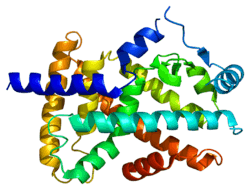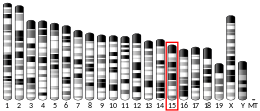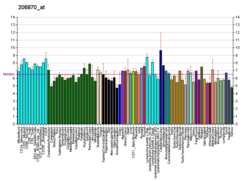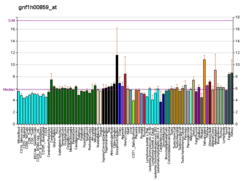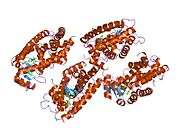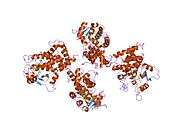Peroxisome proliferator-activated receptor alpha
Peroxisome proliferator-activated receptor alpha (PPAR-alpha), also known as NR1C1 (nuclear receptor subfamily 1, group C, member 1), is a nuclear receptor protein that in humans is encoded by the PPARA gene.[5] Together with peroxisome proliferator-activated receptor delta and peroxisome proliferator-activated receptor gamma, PPAR-alpha is part of the subfamily of peroxisome proliferator-activated receptors. It was the first member of the PPAR family to be cloned in 1990 by Stephen Green and has been identified as the nuclear receptor for a diverse class of rodent hepatocarcinogens that causes proliferation of peroxisomes.[6]
Expression
PPAR-alpha is primarily activated through ligand binding. Endogenous ligands include fatty acids such as arachidonic acid as well as other polyunsaturated fatty acids and various fatty acid-derived compounds such as certain members of the 15-hydroxyicosatetraenoic acid family of arachidonic acid metabolites, e.g. 15(S)-HETE, 15(R)-HETE, and 15(S)-HpETE and 13-hydroxyoctadecadienoic acid, a linoleic acid metabolite. Many of the effects of palmitoleic acid are due to its activation of PPAR-alpha.[7] Synthetic ligands include the fibrate drugs, which are used to treat hyperlipidemia, and a diverse set of insecticides, herbicides, plasticizers, and organic solvents collectively referred to as peroxisome proliferators.
Function

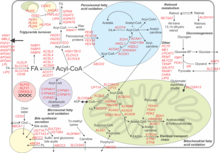
PPAR-alpha is a transcription factor and a major regulator of lipid metabolism in the liver. PPAR-alpha is activated under conditions of energy deprivation and is necessary for the process of ketogenesis, a key adaptive response to prolonged fasting.[8][9] Activation of PPAR-alpha promotes uptake, utilization, and catabolism of fatty acids by upregulation of genes involved in fatty acid transport, fatty acid binding and activation, and peroxisomal and mitochondrial fatty acid β-oxidation.[10]
Tissue distribution
Expression of PPAR-alpha is highest in tissues that oxidize fatty acids at a rapid rate. In rodents, highest mRNA expression levels of PPAR-alpha are found in liver and brown adipose tissue, followed by heart and kidney.[11] Lower PPAR-alpha expression levels are found in small and large intestine, skeletal muscle and adrenal gland. Human PPAR-alpha seems to be expressed more equally among various tissues, with high expression in liver, intestine, heart, and kidney.
Knockout studies
Studies using mice lacking functional PPAR-alpha indicate that PPAR-alpha is essential for induction of peroxisome proliferation by a diverse set of synthetic compounds referred to as peroxisome proliferators.[12] Mice lacking PPAR-alpha also have an impaired response to fasting, characterized by major metabolic perturbations including low plasma levels of ketone bodies, hypoglycemia, and fatty liver.[8]
Pharmacology
PPAR-alpha is the pharmaceutical target of fibrates, a class of drugs used in the treatment of dyslipidemia. Fibrates effectively lower serum triglycerides and raises serum HDL-cholesterol levels.[13] Although clinical benefits of fibrate treatment have been observed, the overall results are mixed and have led to reservations about the broad application of fibrates for the treatment of coronary heart disease, in contrast to statins. PPAR-alpha agonists may carry therapeutic value for the treatment of non-alcoholic fatty liver disease. PPAR-alpha may also be a site of action of certain anticonvulsants.[14][15]
Target genes
PPAR-alpha governs biological processes by altering the expression of a large number of target genes. Accordingly, the functional role of PPAR-alpha is directly related to the biological function of its target genes. Gene expression profiling studies have indicated that PPAR-alpha target genes number in the hundreds.[10] Classical target genes of PPAR-alpha include PDK4, ACOX1, and CPT1. Low and high throughput gene expression analysis have allowed the creation of comprehensive maps illustrating the role of PPAR-alpha as master regulator of lipid metabolism via regulation of numerous genes involved in various aspects of lipid metabolism. The maps, constructed for mouse liver and human liver, put PPAR-alpha at the center of a regulatory hub impacting fatty acid uptake and intracellular binding, mitochondrial β-oxidation and peroxisomal fatty acid oxidation, ketogenesis, triglyceride turnover, gluconeogenesis, and bile synthesis/secretion.
Interactions
Peroxisome proliferator-activated receptor alpha has been shown to interact with:
References
- GRCh38: Ensembl release 89: ENSG00000186951 - Ensembl, May 2017
- GRCm38: Ensembl release 89: ENSMUSG00000022383 - Ensembl, May 2017
- "Human PubMed Reference:". National Center for Biotechnology Information, U.S. National Library of Medicine.
- "Mouse PubMed Reference:". National Center for Biotechnology Information, U.S. National Library of Medicine.
- Sher T, Yi HF, McBride OW, Gonzalez FJ (June 1993). "cDNA cloning, chromosomal mapping, and functional characterization of the human peroxisome proliferator activated receptor". Biochemistry. 32 (21): 5598–604. doi:10.1021/bi00072a015. PMID 7684926.
- Issemann I, Green S (October 1990). "Activation of a member of the steroid hormone receptor superfamily by peroxisome proliferators". Nature. 347 (6294): 645–54. doi:10.1038/347645a0. PMID 2129546.
- de Souza CO, Vannice GK, Rosa Neto JC, Calder PC (2018). "Is Palmitoleic Acid a Plausible Nonpharmacological Strategy to Prevent or Control Chronic Metabolic and Inflammatory Disorders?". Molecular Nutrition & Food Research. 62 (1). doi:10.1002/mnfr.201700504. PMID 28980402.
- Kersten S, Seydoux J, Peters JM, Gonzalez FJ, Desvergne B, Wahli W (June 1999). "Peroxisome proliferator-activated receptor alpha mediates the adaptive response to fasting". J Clin Invest. 103 (11): 1489–98. doi:10.1172/JCI6223. PMC 408372. PMID 10359558.
- Grabacka M, Pierzchalska M, Dean M, Reiss K (2016). "Regulation of Ketone Body Metabolism and the Role of PPARα". International Journal of Molecular Sciences. 17 (12): E2093. doi:10.3390/ijms17122093. PMC 5187893. PMID 27983603.
- Kersten S (2014). "Integrated physiology and systems biology of PPARα". Molecular Metabolism. 3 (4): 354–371. doi:10.1016/j.molmet.2014.02.002. PMC 4060217. PMID 24944896.
- Braissant O, Foufelle F, Scotto C, Dauça M, Wahli W (January 1995). "Differential expression of peroxisome proliferator-activated receptors (PPARs): tissue distribution of PPAR-alpha, -beta, and -gamma in the adult rat". Endocrinology. 137 (1): 354–66. doi:10.1210/endo.137.1.8536636. PMID 8536636.
- Lee SS, Pineau T, Drago J, Lee EJ, Owens JW, Kroetz DL, Fernandez-Salguero PM, Westphal H, Gonzalez FJ (June 1995). "Targeted disruption of the alpha isoform of the peroxisome proliferator-activated receptor gene in mice results in abolishment of the pleiotropic effects of peroxisome proliferators". Mol Cell Biol. 15 (6): 3012–22. doi:10.1128/MCB.15.6.3012. PMC 230532. PMID 7539101.
- Staels B, Maes M, Zambon A (September 2008). "Peroxisome Fibrates and future PPARα agonists in the treatment of cardiovascular disease". Nat Clin Pract Cardiovasc Med. 5 (9): 542–53. doi:10.1038/ncpcardio1278. PMID 18628776.
- Puligheddu M, Pillolla G, Melis M, Lecca S, Marrosu F, De Montis MG, Scheggi S, Carta G, Murru E, Aroni S, Muntoni AL, Pistis M (2013). "PPAR-alpha agonists as novel antiepileptic drugs: preclinical findings". PLoS ONE. 8 (5): e64541. doi:10.1371/journal.pone.0064541. PMC 3664607. PMID 23724059.
- Citraro R, Russo E, Scicchitano F, van Rijn CM, Cosco D, Avagliano C, Russo R, D'Agostino G, Petrosino S, Guida F, Gatta L, van Luijtelaar G, Maione S, Di Marzo V, Calignano A, De Sarro G (2013). "Antiepileptic action of N-palmitoylethanolamine through CB1 and PPAR-α receptor activation in a genetic model of absence epilepsy". Neuropharmacology. 69: 115–26. doi:10.1016/j.neuropharm.2012.11.017. PMID 23206503.
- Sumanasekera WK, Tien ES, Turpey R, Vanden Heuvel JP, Perdew GH (February 2003). "Evidence that peroxisome proliferator-activated receptor alpha is complexed with the 90-kDa heat shock protein and the hepatitis virus B X-associated protein 2". J. Biol. Chem. 278 (7): 4467–73. doi:10.1074/jbc.M211261200. PMID 12482853.
- Dowell P, Ishmael JE, Avram D, Peterson VJ, Nevrivy DJ, Leid M (December 1997). "p300 functions as a coactivator for the peroxisome proliferator-activated receptor alpha". J. Biol. Chem. 272 (52): 33435–43. doi:10.1074/jbc.272.52.33435. PMID 9407140.
- Dowell P, Ishmael JE, Avram D, Peterson VJ, Nevrivy DJ, Leid M (May 1999). "Identification of nuclear receptor corepressor as a peroxisome proliferator-activated receptor alpha interacting protein". J. Biol. Chem. 274 (22): 15901–7. doi:10.1074/jbc.274.22.15901. PMID 10336495.
- Treuter E, Albrektsen T, Johansson L, Leers J, Gustafsson JA (June 1998). "A regulatory role for RIP140 in nuclear receptor activation". Mol. Endocrinol. 12 (6): 864–81. doi:10.1210/mend.12.6.0123. PMID 9626662.
Further reading
- Rakhshandehroo M, Hooiveld G, Müller M, Kersten S (2009). "Comparative analysis of gene regulation by the transcription factor PPARalpha between mouse and human". PLoS ONE. 4 (8): e6796. doi:10.1371/journal.pone.0006796. PMC 2729378. PMID 19710929.
- Berger J, Moller DE (2002). "The mechanisms of action of PPARs". Annu. Rev. Med. 53: 409–35. doi:10.1146/annurev.med.53.082901.104018. PMID 11818483.
- Kuenzli S, Saurat JH (2003). "Peroxisome proliferator-activated receptors in cutaneous biology". Br. J. Dermatol. 149 (2): 229–36. doi:10.1046/j.1365-2133.2003.05532.x. PMID 12932225.
- Mandard S, Müller M, Kersten S (2004). "Peroxisome proliferator-activated receptor alpha target genes". Cell. Mol. Life Sci. 61 (4): 393–416. doi:10.1007/s00018-003-3216-3. PMID 14999402.
- van Raalte DH, Li M, Pritchard PH, Wasan KM (2005). "Peroxisome proliferator-activated receptor (PPAR)-alpha: a pharmacological target with a promising future". Pharm. Res. 21 (9): 1531–8. doi:10.1023/B:PHAM.0000041444.06122.8d. PMID 15497675.
- Lefebvre P, Chinetti G, Fruchart JC, Staels B (2006). "Sorting out the roles of PPAR alpha in energy metabolism and vascular homeostasis". J. Clin. Invest. 116 (3): 571–80. doi:10.1172/JCI27989. PMC 1386122. PMID 16511589.
- Mukherjee R, Jow L, Noonan D, McDonnell DP (1995). "Human and rat peroxisome proliferator activated receptors (PPARs) demonstrate similar tissue distribution but different responsiveness to PPAR activators". J. Steroid Biochem. Mol. Biol. 51 (3–4): 157–66. doi:10.1016/0960-0760(94)90089-2. PMID 7981125.
- Miyata KS, McCaw SE, Patel HV, Rachubinski RA, Capone JP (1996). "The orphan nuclear hormone receptor LXR alpha interacts with the peroxisome proliferator-activated receptor and inhibits peroxisome proliferator signaling". J. Biol. Chem. 271 (16): 9189–92. doi:10.1074/jbc.271.16.9189. PMID 8621574.
- Chu R, Lin Y, Rao MS, Reddy JK (1996). "Cloning and identification of rat deoxyuridine triphosphatase as an inhibitor of peroxisome proliferator-activated receptor alpha". J. Biol. Chem. 271 (44): 27670–6. doi:10.1074/jbc.271.44.27670. PMID 8910358.
- Tugwood JD, Aldridge TC, Lambe KG, Macdonald N, Woodyatt NJ (1997). "Peroxisome proliferator-activated receptors: structures and function". Ann. N. Y. Acad. Sci. 804: 252–65. doi:10.1111/j.1749-6632.1996.tb18620.x. PMID 8993548.
- Li H, Gomes PJ, Chen JD (1997). "RAC3, a steroid/nuclear receptor-associated coactivator that is related to SRC-1 and TIF2". Proc. Natl. Acad. Sci. U.S.A. 94 (16): 8479–84. doi:10.1073/pnas.94.16.8479. PMC 22964. PMID 9238002.
- Dowell P, Ishmael JE, Avram D, Peterson VJ, Nevrivy DJ, Leid M (1998). "p300 functions as a coactivator for the peroxisome proliferator-activated receptor alpha". J. Biol. Chem. 272 (52): 33435–43. doi:10.1074/jbc.272.52.33435. PMID 9407140.
- Inoue I, Shino K, Noji S, Awata T, Katayama S (1998). "Expression of peroxisome proliferator-activated receptor alpha (PPAR alpha) in primary cultures of human vascular endothelial cells". Biochem. Biophys. Res. Commun. 246 (2): 370–4. doi:10.1006/bbrc.1998.8622. PMID 9610365.
- Treuter E, Albrektsen T, Johansson L, Leers J, Gustafsson JA (1998). "A regulatory role for RIP140 in nuclear receptor activation". Mol. Endocrinol. 12 (6): 864–81. doi:10.1210/mend.12.6.0123. PMID 9626662.
- Rubino D, Driggers P, Arbit D, Kemp L, Miller B, Coso O, Pagliai K, Gray K, Gutkind S, Segars J (1998). "Characterization of Brx, a novel Dbl family member that modulates estrogen receptor action". Oncogene. 16 (19): 2513–26. doi:10.1038/sj.onc.1201783. PMID 9627117.
- Yuan CX, Ito M, Fondell JD, Fu ZY, Roeder RG (1998). "The TRAP220 component of a thyroid hormone receptor- associated protein (TRAP) coactivator complex interacts directly with nuclear receptors in a ligand-dependent fashion". Proc. Natl. Acad. Sci. U.S.A. 95 (14): 7939–44. doi:10.1073/pnas.95.14.7939. PMC 20908. PMID 9653119.
- Chinetti G, Griglio S, Antonucci M, Torra IP, Delerive P, Majd Z, Fruchart JC, Chapman J, Najib J, Staels B (1998). "Activation of proliferator-activated receptors alpha and gamma induces apoptosis of human monocyte-derived macrophages". J. Biol. Chem. 273 (40): 25573–80. doi:10.1074/jbc.273.40.25573. PMID 9748221.
- Costet P, Legendre C, Moré J, Edgar A, Galtier P, Pineau T (1998). "Peroxisome proliferator-activated receptor alpha-isoform deficiency leads to progressive dyslipidemia with sexually dimorphic obesity and steatosis". J. Biol. Chem. 273 (45): 29577–85. doi:10.1074/jbc.273.45.29577. PMID 9792666.
- Masuda N, Yasumo H, Furusawa T, Tsukamoto T, Sadano H, Osumi T (1998). "Nuclear receptor binding factor-1 (NRBF-1), a protein interacting with a wide spectrum of nuclear hormone receptors". Gene. 221 (2): 225–33. doi:10.1016/S0378-1119(98)00461-2. PMID 9795230.
- Rakhshandehroo M, Sanderson LM, Matilainen M, Stienstra R, Carlberg C, de Groot PJ, Müller M, Kersten S (2007). "Comprehensive analysis of PPARalpha-dependent regulation of hepatic lipid metabolism by expression profiling". PPAR Res. 2007: 1–13. doi:10.1155/2007/26839. PMC 2233741. PMID 18288265.
This article incorporates text from the United States National Library of Medicine, which is in the public domain.
